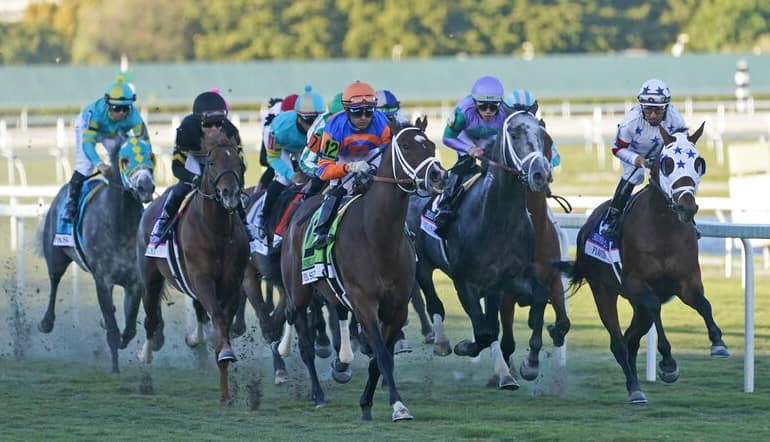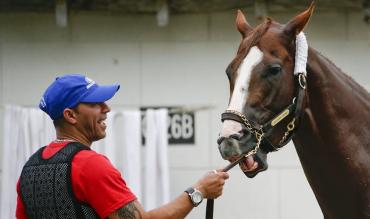-
There are several types of bridle that can be fitted onto a racehorse
-
Some bridles are “bitless”
-
Paddock watching a horse in its bridle can aid your punting
What Is A Bridle And How Does It Work?
Racehorses are very powerful animals and in order to be able to ride and control them some sort of contraption needs to be applied.
This item is universally known as the bridle. The whole relationship between a horse and its rider rests in the correct use of the bridle.
The bridle is a piece of headgear that the racehorse wears in order for the jockey to be able to steer and control it.
The bridle generally consists of a bit that runs between the horse’s teeth attached to head straps, while the long reins come back down the neck and into the hands of the jockey.
If horses were not fitted with a bridle then they would be unsteerable and their riders would be plonked on the floor after a few strides.
Bridle Types
Naturally bridles come in all sorts of designs and types and some work for particular horses better than others. The following bridal types can typically be found on racehorses today:
-
Anatomic Bridle
Anatomical bridles are designed with the horse’s anatomy in mind. They allow the horse to be more comfortable and move freely.
This type of bridle is designed and cut to be a specific shape to help prevent pressure on a horse’s facial nerves.
-
Micklem Bridle
The Micklem bridle is designed from the inside out and from the shape of the skull itself.
This is to avoid any pressure on the five areas which consistently cause discomfort with traditional headwear.
-
Double Bridle
The double bridle (also known as the Weymouth Bridle) consists of two bits: the bridoon (snaffle bit) and the curb.
The double bridle can have a very sharp effect on the horse's mouth due to the increased leverage it offers is therefore only suitable for experienced riders.
-
Schockemohle Bridle
Schockemohle are designed with a specifically shaped headpiece and nose band to release pressure from the horses head, nose and neck, making sure that the horse has the maximum comfort through extra padding.
-
Bitless Bridle
Bitless bridles have been observed to solve a number of issues, from head shaking and bridle lameness to napping, rearing and anxiety.
Ridden behaviours like head nodding and excessive salivation also lead to riders and trainers to explore bitless options for their horse.
-
Snaffle Bridle
The snaffle is the most commonly used bridle because of its versatility and functionality. The snaffle bridle can be used for most horse disciplines including jumping, dressage, and trail riding.
It can be used with a snaffle bit or with a Pelham or curb bit. A racing term you sometimes hear which is derived from this bridle name is “the horse was on the snaff”.
On The Bridle vs Off The Bridle
These are very familiar terms in the sport of horse racing but what do they actually mean in practice?
The term “on the bridle” is used when a horse has got used to the bit being between its teeth and the reins flow back naturally to the jockey.
Sometimes horses don’t take to the bridle and they become frustrated and fractious in the paddock. Quite often you will see a horse fighting against the bit with its tongue in the parade ring.
Generally when the jockey climbs on board they put the horse at ease and familiarise it with the bridle. In most cases the horse will settle and will be ready to race.
Conversely, “off the bridle” is a phrase used when the horse isn’t travelling well during a race. Quite often later down the line, such horses are always equipped with cheekpieces.
If a racing pundit or commentator ever says of a horse ‘it won on the bridle’ it generally means it won with the minimum of fuss and did not need to be ridden vigorously.
Do Bridles Impact Betting On Horse Racing?
Horse racing is fundamentally a betting sport and punters can quite often gain an edge in their betting if they can identify which horses are on or off the bridle.
As well as identifying which horses are comfortable in the paddock with their bridle, you can also work out which ones are at ease with their equipment whilst heading down to the start.
Jumps races are much longer than flat races so a horse is more likely to come off the bridle in the NH sphere, In short sprint races horses don’t generally come off the bridle because the races are over quite quickly.
When a horse reaches the limit of its stamina reserves it will come off the bridle and invariably will struggle to hold its place.
Being able to identify when a horse has come off the bridle is an important tool and skill for successful horse racing punters, especially those that play the in-running markets with their horse racing online bets.
A trained eye can give you an increased advantage over your fellow bettors.
You must remember that for 90% of the race the jockey's job is to slow the horse down and save his energy for the concluding stages of the race.
A horse that is running 'on the bridle' is still being held back from going full speed by the jockey pulling him/her back with his the reins.

A horse that is running 'off the bridle' is one where the jockey has had to let go of his tight grip and allow the horse to run faster to maintain its momentum.
The jockey lets some slack go out of his reins because he is struggling to keep up with the other horses that are still around him and are still on the bridle. His mount will probably now struggle to maintain those exertions for a prolonged period of time.
Being ridden 'off the bridle' is generally an ominous sign for a punter as the horse is highly likely to be overtaken and swamped by the chasing pack.
At the end of any given race most horses will be 'off the bridle' because the battle to the line saps up all their reserves of energy. Of course there are some exceptions...
Some horses are simply lazy travellers and need to be cajoled along by the jockey for most of the race.
Many horse racing commentators will incorrectly describe these types as being 'off the bridle' when in fact it is just the way they always run and they tend not to find much extra when let off the bridle.
Sometimes horses win very easily and visually never come 'off the bridle''. The commentators and pundits will often make a big deal about this because it leads to the notion that they could have won by a lot further if the jockey let them off the bridle.
Often you will hear associated descriptions such as “he won hard held” and “the jockey had a double handful'” both implying that the horse won even though the jockey still had hold of a tight rein.
A high percentage of horses that score in this manner are quite often the NAP of the day in the national newspaper racing pages.
*Credit for all of the photos in this article belongs to AP Photo*
FIRST PUBLISHED: 9th March 2022
